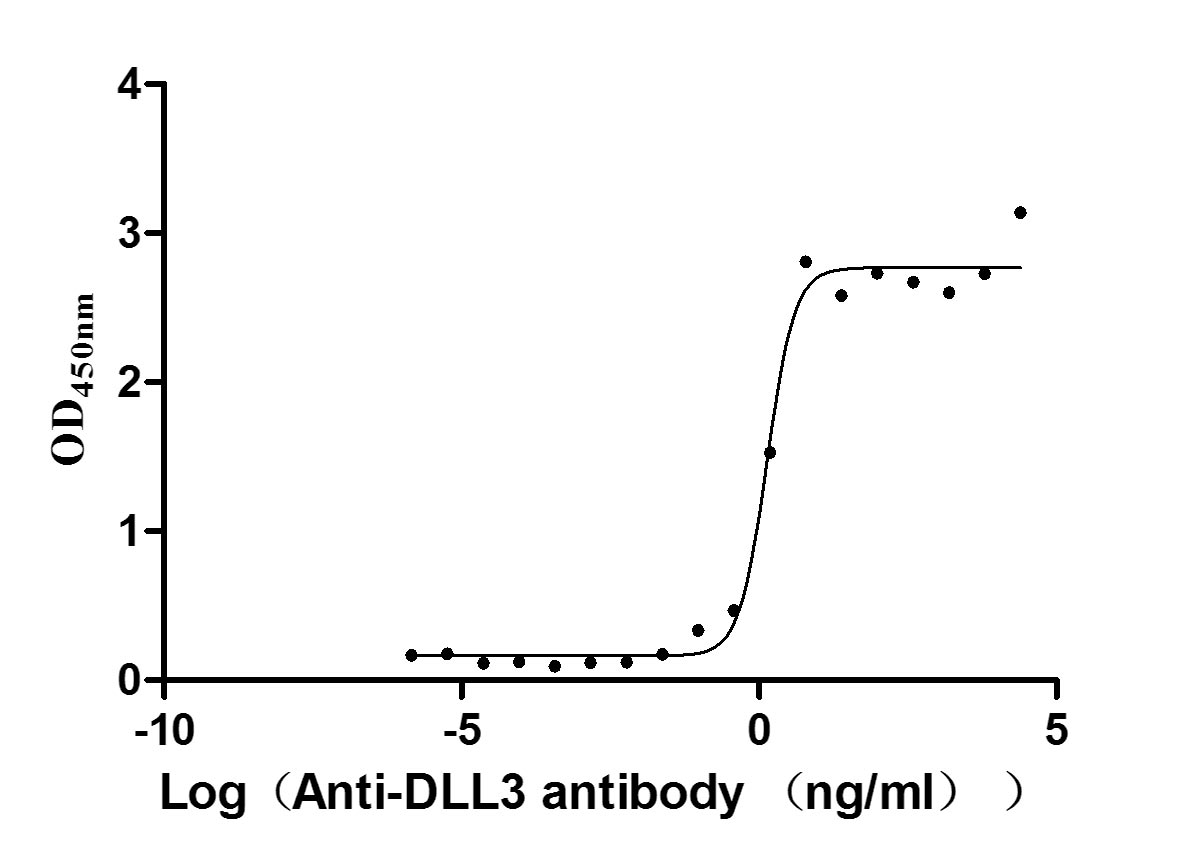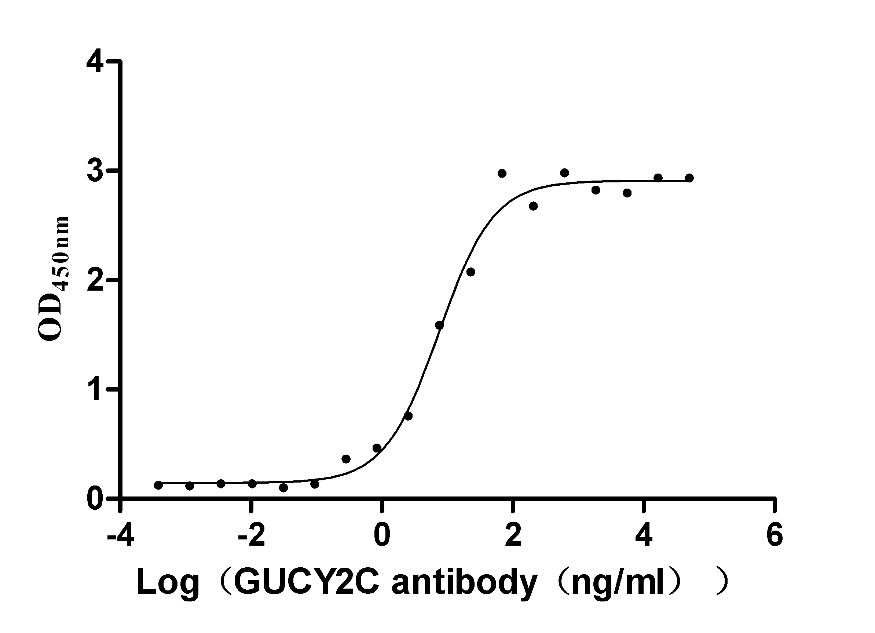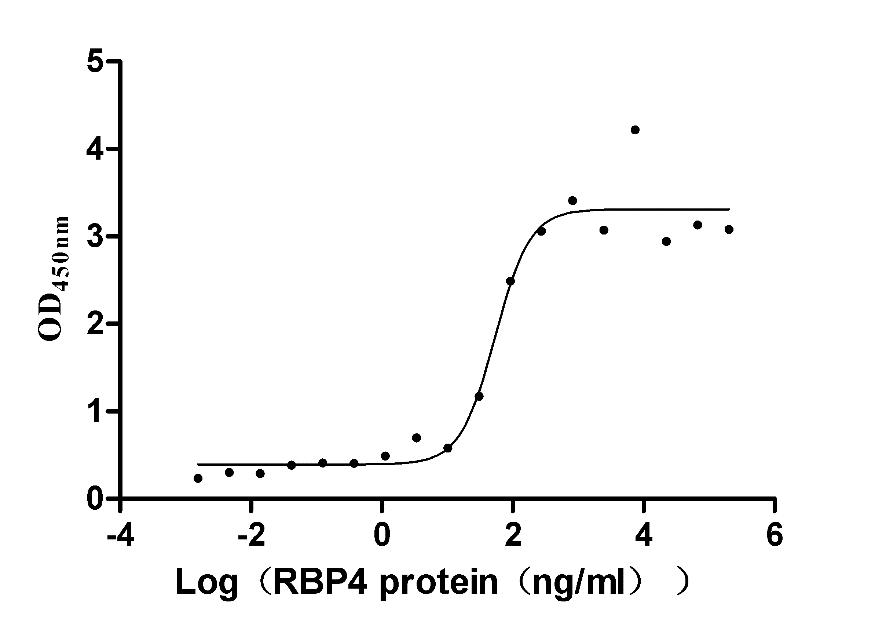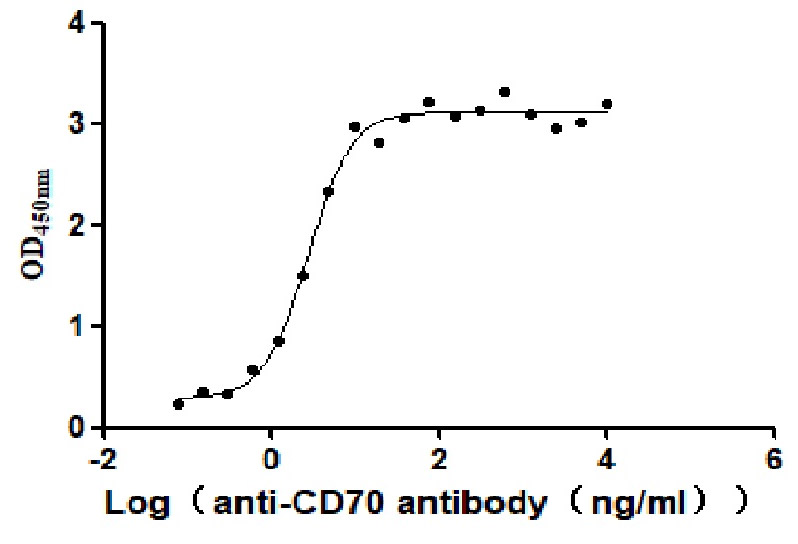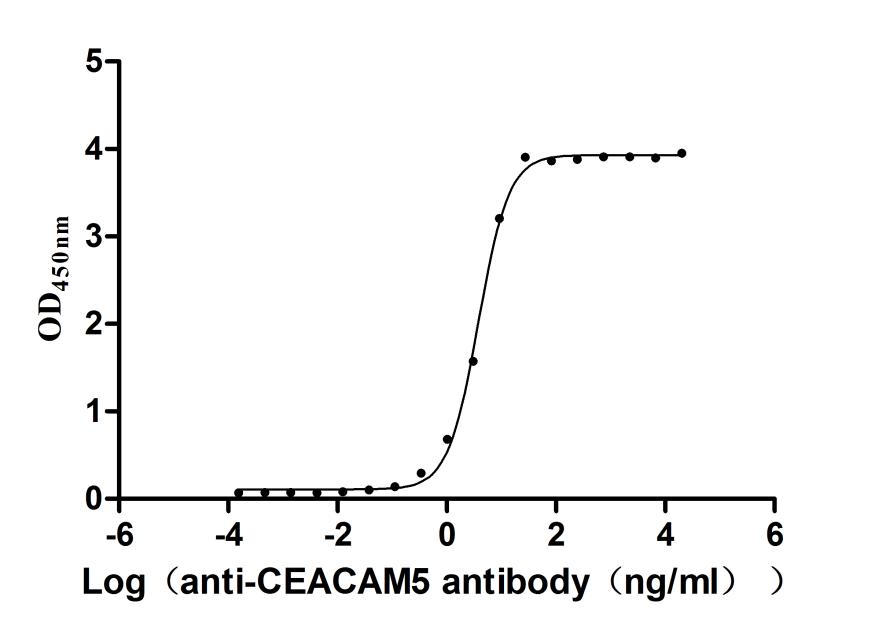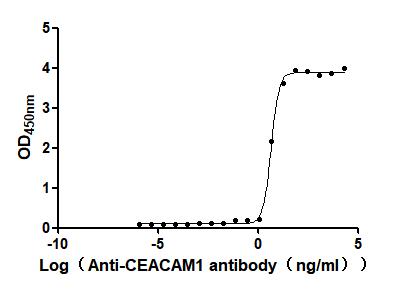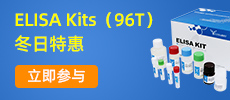Recombinant Human Claudin-6 (CLDN6), partial
-
中文名稱:Recombinant Human Claudin-6 (CLDN6), partial
-
品名簡稱:Recombinant Human CLDN6 protein, partial
-
貨號:CSB-BP005508HU(A5)
-
說明書:
-
規(guī)格:¥3168
-
圖片:
-
其他:
產(chǎn)品詳情
-
純度:Greater than 85% as determined by SDS-PAGE.
-
生物活性:Not Test
-
基因名:
-
Uniprot No.:
-
種屬:Homo sapiens (Human)
-
蛋白長度:Partial
-
來源:Baculovirus
-
分子量:24.7 kDa
-
表達區(qū)域:2-220aa
-
氨基酸序列ASAGMQILGVVLTLLGWVNGLVSCALPMWKVTAFIGNSIVVAQVVWEGLWMSCVVQSTGQMQCKVYDSLLALPQDLQAARALCVIALLVALFGLLVYLAGAKCTTCVEEKDSKARLVLTSGIVFVISGVLTLIPVCWTAHAIIRDFYNPLVAEAQKRELGASLYLGWAASGLLLLGGGLLCCTCPSGGSQGPSHYMARYSTSAPAISRGPSEYPTKNYV
Note: The complete sequence may include tag sequence, target protein sequence, linker sequence and extra sequence that is translated with the protein sequence for the purpose(s) of secretion, stability, solubility, etc.
If the exact amino acid sequence of this recombinant protein is critical to your application, please explicitly request the full and complete sequence of this protein before ordering. -
蛋白標簽:N-terminal 10xHis-tagged and C-terminal Twin-Strep-tagged
-
產(chǎn)品提供形式:Liquid or Lyophilized powder
Note: We will preferentially ship the format that we have in stock, however, if you have any special requirement for the format, please remark your requirement when placing the order, we will prepare according to your demand. -
緩沖液:If the delivery form is liquid, the default storage buffer is Tris/PBS-based buffer, 5%-50% glycerol. If the delivery form is lyophilized powder, the buffer before lyophilization is Tris/PBS-based buffer, 6% Trehalose, pH 8.0.
-
復(fù)溶:We recommend that this vial be briefly centrifuged prior to opening to bring the contents to the bottom. Please reconstitute protein in deionized sterile water to a concentration of 0.1-1.0 mg/mL.We recommend to add 5-50% of glycerol (final concentration) and aliquot for long-term storage at -20℃/-80℃. Our default final concentration of glycerol is 50%. Customers could use it as reference.
-
儲存條件:Store at -20°C/-80°C upon receipt, aliquoting is necessary for mutiple use. Avoid repeated freeze-thaw cycles.
-
保質(zhì)期:The shelf life is related to many factors, storage state, buffer ingredients, storage temperature and the stability of the protein itself.
Generally, the shelf life of liquid form is 6 months at -20°C/-80°C. The shelf life of lyophilized form is 12 months at -20°C/-80°C. -
貨期:Basically, we can dispatch the products out in 3-7 working days after receiving your orders. Delivery time may differ from different purchasing way or location, please kindly consult your local distributors for specific delivery time.
-
注意事項:Repeated freezing and thawing is not recommended. Store working aliquots at 4℃ for up to one week.
-
Datasheet & COA:Please contact us to get it.
相關(guān)產(chǎn)品
靶點詳情
-
功能:Plays a major role in tight junction-specific obliteration of the intercellular space.; (Microbial infection) Acts as a receptor for hepatitis C virus (HCV) entry into hepatic cells.
-
基因功能參考文獻:
- Antibodies recognizing native CLDN6 as displayed on cell surfaces and mediating complement-dependent cytotoxicity were elicited in vaccinated animals. The data suggest applications of CLDN6 displaying Virus-like particles in cancer immunotherapy. PMID: 29131519
- these results suggest that Helicobacter pylori lipopolysaccharide induces TLR2 expression in the gastric adenocarcinoma cells, and that the longer the exposure to lipopolysaccharide, the greater the expression of TLR2 in the cell membrane; consequently the expression of claudin-4, -6, -7 and -9 also increases PMID: 29031421
- Study provides evidence that high expression of CLDN6 confers chemoresistance on breast cancer which is mediated by GSTP1, the activity of which is regulated by p53. PMID: 29116019
- CLDN6 enhances the chemoresistance to ADM via activating the AF-6/ERK signaling pathway and up-regulating cancer stem cell characters in MDAMB231 cells. PMID: 29159771
- we demonstrated that the downregulation of CLDN6 is regulated through promoter methylation by DNMT1, which depends on the SMAD2 pathway, and that CLDN6 is a key regulator in the SMAD2/DNMT1/CLDN6 pathway to inhibit EMT, migration and invasion of breast cancer cells PMID: 28867761
- In conclusion, this information from bioinformatics analysis will help future attempts to better understand CLDN6 regulation and functions. PMID: 28656265
- high expression of CLDN 6 was observed in approx. 65% of the myxofibrosarcomas, whereas the benign soft tissue tumors did not show a high expression of CLDN 6. The expression of CLDN 6 in the myxofibrosarcomas was significantly higher than those of other tumor specimens. Among the myxofibrosarcomas, the high expression of CLDN 6 was correlated with high FNCLCC grades and high AJCC stages. PMID: 28476380
- Results show that DNA methylation down-regulates CLDN6 expression through MeCP2 binding to the CLDN6 promoter, deacetylating H3 and H4, and altering chromatin structure, consequently promoting migratory and invasive phenotype in breast cancer cells. PMID: 27461117
- Cldn6 was decreased in alveolar type II-like epithelial cells (A549) and primary small airway epithelial cells when exposed to cigarette smoke ext PMID: 27982694
- suggest that claudin-6 induces MMP-2 activation through claudin-1 membrane expression PMID: 27914788
- Data show that claudin-6 (CLDN6) R209Q and occludin (OCLN) P24A mutations do not affect HCV pseudoparticles (HCVpp) entry. PMID: 26561856
- The expression of ASK1 is correlated with the level of claudin-6 in cervical carcinoma cells and tissues. PMID: 26191261
- High levels of CLDN6 are associated with non-small-cell lung cancer. PMID: 24710653
- The expression of claudin-6 was down regulated in gastric cancer tissue. PMID: 23919729
- Only some hepatitis C virus strains efficiently use CLDN6 for infection. PMID: 23775920
- This work provides a proof of concept for the use of Claudin-6 to eliminate residual undifferentiated human pluripotent stem cells from culture. PMID: 23778593
- Although claudin-6 and claudin-9 can serve as entry factors in cell lines, hepatitis C virus infection into human hepatocytes is not dependent on claudin-6 and claudin-9. PMID: 23864633
- ASK1 signal may play a positive role in the inhibitory effect of claudin-6 in breast cancer. PMID: 22925655
- Our results show that claudin-6 protein is significantly down-regulated in breast invasive ductal carcinomas PMID: 22455563
- CLDN6 is not a specific biomarker for atypical teratoid rhabdoid tumors as it is expressed in a variety of other pediatric CNS and soft tissue tumors. PMID: 21989342
- 17beta-E2 might regulate the expression of claudin-6 and inhibit the proliferation and migration of MCF-7 cells. PMID: 20388399
- Increased expression of claudin-6, claudin-7, or claudin-9 is sufficient to enhance tumorigenic properties of a gastric adenocarcinoma cell line. PMID: 20874001
- CLDN6 may be a useful positive marker to help further identify atypical teratoid/rhabdoid tumors for diagnostic and treatment purposes PMID: 19220299
- Claudins 6, 7, and 9 expressions are closely related to gastric carcinogenesis PMID: 19960275
- The up-regulation of claudin-6 expression in MCF-7 breast cancer cells suppresses their malignant phenotypes with a correlation with the restoration of tight junction integrity. PMID: 20367941
- claudin-6, downregulates the malignant phenotype of breast carcinoma. PMID: 20215972
- Claudin 6 was not found in epithelioid glioblastomas or rhabdoid glioblastomas. PMID: 20118769
- CLDN6 and CLDN9, but not CLDN1, are expressed in peripheral blood mononuclear cells, an additional site of HCV replication. PMID: 17804490
- claudin-6 and claudin-9 expressed in CD81+ cells also enable the entry of HCV pseudoparticles derived from six of the major genotypes. PMID: 18234789
- CLDN6, clustered with CLDN9 at human chromosome 16p13.3, is a four-transmembrane protein with WWCC motif, defined by W-X(17-22)-W-X(2)-C-X(8-10)-C. PMID: 12736707
顯示更多
收起更多
-
亞細胞定位:Cell junction, tight junction. Cell membrane; Multi-pass membrane protein.
-
蛋白家族:Claudin family
-
組織特異性:Expressed in the liver, in peripheral blood mononuclear cells and hepatocarcinoma cell lines.
-
數(shù)據(jù)庫鏈接:
Most popular with customers
-
Recombinant Human Delta-like protein 3 (DLL3), partial (Active)
Express system: Mammalian cell
Species: Homo sapiens (Human)
-
Recombinant Human Heat-stable enterotoxin receptor (GUCY2C), partial (Active)
Express system: Mammalian cell
Species: Homo sapiens (Human)
-
Recombinant Mouse Retinol-binding protein 4 (Rbp4) (Active)
Express system: Mammalian cell
Species: Mus musculus (Mouse)
-
Recombinant Human CD70 antigen (CD70), partial (Active)
Express system: Mammalian cell
Species: Homo sapiens (Human)
-
Express system: Mammalian cell
Species: Macaca mulatta (Rhesus macaque)
-
Express system: Mammalian cell
Species: Homo sapiens (Human)

-SDS.jpg)

